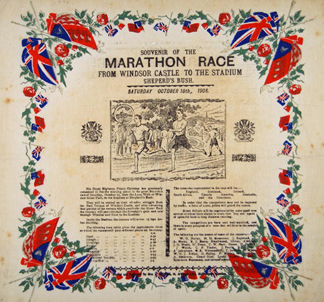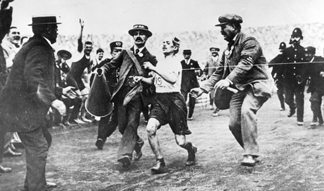Published 11/07/2012
On July 24th, 1908, 100,000 people were crammed into White City Stadium for the Olympic marathon. Among the revelers were the Daily Mail's correspondent, Sir Arthur Conan Doyle, and Queen Alexandra (Queen Elizabeth's grandmother). Fifty-five athletes from 16 countries started the marathon that day but only 27 would finish. Charles Hefferon, a South African, was in the lead for most of the second half of the race until a 5ft 2in Italian pastry chef named Dorando Pietri passed him with only two miles to go. Conan Doyle described him as "a little man, a tiny boy-like creature." Upon entering the stadium it was evident that Pietri's stamina was waivering when he collapsed several times and ran the wrong way. Not far the from the finish line, he fell again and Olympic officials went to his aid. The second runner to enter the stadium was an American, Johnny Hayes, who immediately lodged a complaint against Pietri. Although Pietri finished the race with a time of 2:54:46, he was disqualified. |
|
"He run-a, run-a, run-a, run like anything." - Irving Berlin's "Dorando"
| Conan Doyle wrote, "It is horrible, and yet fascinating, this struggle between a set purpose and an utterly exhausted frame," and "Amid stooping figures and grasping hands I caught a glimpse of the haggard, yellow face, the glazed, expressionless eyes, the long, black hair streaked across the bow. Surely he is done now. He cannot rise again." Hayes was awarded the gold, but Pietri's effort impressed the Queen so much, she presented him with a silver cup at the closing ceremony. Pietri's feat was also immortalized in a song written by a young Irving Berlin, entitled "Dorando." |
Theories abound on what caused Pietri to collapse, including the warm July temperatures and Pietri's own suspicion of too much steak for breakfast. More recently, people have attributed the incident to a mid-race intake of strychnine (a poison found in pesticides!) diluted in wine that was a common performance enhancer at that time. Two months later, Pietri traveled to New York as he had been challenged to a rematch with Hayes at Madison Square Garden. He had, he said, "done absolutely no training since the day of the marathon" and had unsuccessfuly lobbied for a delay "to give me an opportunity for some real training." It was a very different occasion, run over 262 laps of an indoor track in an atmosphere heavy with dust and tobacco smoke. The event was no less popular than the first: 20,000 fans filled the Garden, with 10,000 left disappointed outside. In what the New York Times described as "the most spectacular foot race that New York ever has witnessed," Pietri won by half a lap, and again, more convincingly still, in a second rematch held the following March.
|
|
Where does the .2 in 26.2 come from?
An interesting side note to this story is how the modern marathon got its official distance of 26.2 miles. The 1908 race was originally supposed to start on a street outside Windsor Castle, but the Queen wanted her children to watch, so the start was moved by a few hundred yards, to a point outside the nursery inside the castle grounds. In order to place the finish line directly in front of the Queen, the officials extended the length of the marathon, which had previously been loosely set at between 25 and 26 miles, to 26 miles and 385 yards, which remains the official marathon distance to this day.





